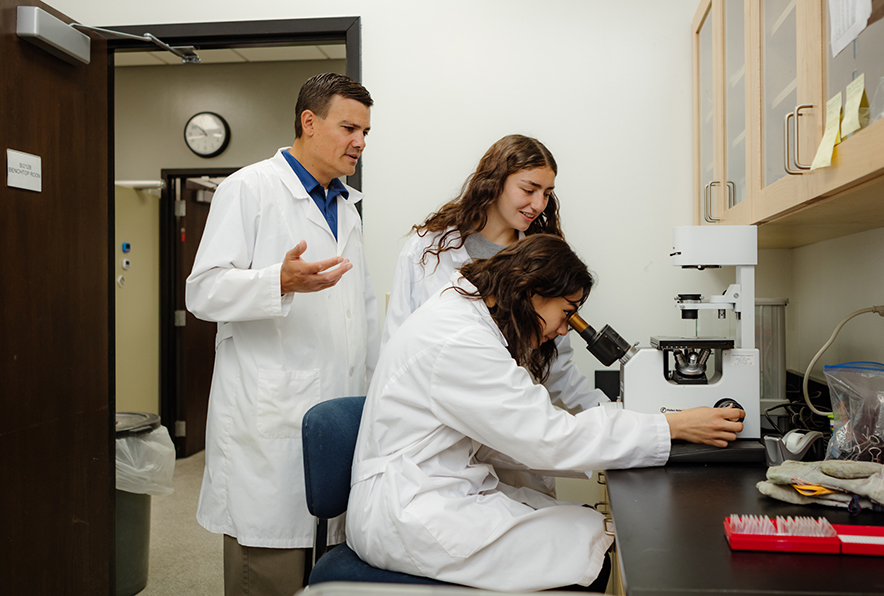Could biological sex play an important role in post-traumatic stress disorder (PTSD) treatments that use the hallucinogen psilocybin, or “magic mushrooms?” Preliminary research conducted at Ohio Northern University indicates that it could. The discovery may have wide-ranging implications for the treatment of various mental illnesses.
Low doses of psilocybin had different effects on lab rats, said Phillip Zoladz, Ph.D., professor of psychology, who is conducting the ongoing research with 13 ONU students. “In males, psilocybin increased the rate of (fear) extinction and promoted a long-term reduction in their fear. In females, psilocybin actually slowed extinction and led to greater fear. It’s an important problem to focus on.”
“Our findings highlight the importance of taking biological sex into consideration when studying the therapeutic value of psychedelic substances. It’s really interesting. The fact that we’ve discovered this difference is significant. And nobody else is looking at it, so I find it exciting,” continued Zoladz, who was one of only a handful of researchers selected to present his findings at a press conference hosted at the Society for Neuroscience’s 2023 conference in Washington, D.C. in November.
Better known as a stigmatized recreational drug, psilocybin, the chemical contained in “magic mushrooms,” is gaining clinical traction for its potential medicinal value.
With decades-old drugs such as Prozac and Zoloft on the market having only limited success with patients, researchers are intent on developing better options.
“For mental illness in general, the psychotropics that we have are just not really effective for a lot of people,” Zoladz said. Scientists are therefore turning back to nature for solutions.
“As the search for novel treatments for mental illness grows, new energy is being focused on older treatments, such as ketamine, and more Schedule I substances, such as marijuana, LSD, and psilocybin,” explains the 2017 article “Clinical potential of psilocybin as a treatment for mental health conditions” in Mental Health Clinician journal.
PTSD affects millions. According to the U.S. Department of Veterans Affairs’ National Center for PTSD, “about six out of every 100 people (or 6% of the U.S. population) will have PTSD at some point in their lives. Women are more likely to develop PTSD than men. About 8 of every 100 women (or 8%) and 4 of every 100 men (or 4%) will have PTSD at some point in their life… in part due to the types of traumatic events that women are more likely to experience—such as sexual assault—compared to men.”
PTSD sufferers often grapple with powerful fear memories that cause distressing physiological and psychological symptoms. For instance, soldiers returning from combat frequently associate environmental stimuli, such as loud noises, smells, visual cues, and more, with negative events they experienced during their service. These environmental cues can trigger strong responses when they return to civilian life, such as panic and anxiety, often triggered by seemingly innocuous events like fireworks.
Exposure therapy, a widely employed approach in the treatment of PTSD, systematically exposes individuals to the stimuli that trigger their fear with the aim of teaching them that these stimuli no longer predict danger; the effectiveness of exposure therapy varies among individuals. This particular PTSD treatment is what Zoladz and his team have been focusing on by investigating whether the fungal psychedelic psilocybin has the potential to augment the fear “extinction” process involved in exposure therapy.
The team’s remarkable results started coming to light in 2023 after perseverance of all kinds.
“A lot of researchers just don’t go through the hassle” of examining Schedule I substances such as psilocybin because of government bureaucracy that requires permission and extensive oversight, said Zoladz. “There’s a lot of red tape.” But, anticipating impactful outcomes, these ONU researchers have forged ahead with scrutinizing this understudied substance.
Zoladz pointed out that few researchers focus on females in their research because of their fluctuating hormone levels and because of the notion – misguided, according to Zoladz – that males and females are not built all that differently. “Neuroscience research clearly shows that there are numerous differences in how males and females behave, at both the behavioral and neurological level,” he noted.
“You have to study females, especially when females are more likely to develop PTSD and depression.”
Psychedelics are well known for their ability to increase serotonin activity, a neurotransmitter associated with mood regulation and fear processing. However, according to Zoladz, the impact of psilocybin on serotonin levels can’t be the sole factor involved with mitigating adverse mental health symptoms.
The ONU research team is expanding its research to examine protein levels in the brains of rats treated with psilocybin. Using Western blotting, the impact of psilocybin on neural plasticity – a term used to describe the ability of cells in the nervous system to change through growth or reorganization – is being considered.
“Maybe psychedelics are something that increase plasticity during therapy and boost the brain’s ability to re-wire itself, thereby weakening connections that result in fear and anxiety in patients,” Zoladz conjectured.
Along with continuing to research the role biological sex plays in psilocybin treatment (they’re hoping to publish their findings this year), the ONU team’s moonshot goal is to find evidence that psilocybin could be used proactively, before people develop, or suffer too long with, debilitating symptoms from mental illnesses. “Would it prevent those fears from forming?” Zoladz wonders.
ONU researchers discover key factor in PTSD treatment method that uses hallucinogenic – Northern News
